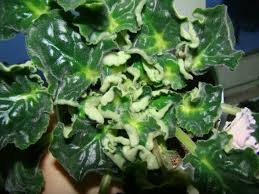African violets are popular houseplants due to their vibrant flowers and velvety foliage. But when the leaves of these delicate plants start to curl, it can be a sign of underlying issues that need attention. Understanding the causes of African violet leaf curling is crucial to maintaining their health and ensuring their ornamental appeal.
We wrote this guide to explore common causes of African violet leaves curling and provide practical solutions to revive and restore your plant’s vitality. By identifying the root causes, you’ll be better equipped to address the specific issues affecting your African violets.

10 Causes of African Violet Leaves Curling
Overwatering
It is a common cause of African violet leaf curling. When the roots are constantly saturated with water, they become waterlogged, leading to oxygen deprivation and root rot. Leaves curling is a way to conserve water and respond to this stress.
Overwatering can create a breeding ground for fungal diseases, further exacerbating leaf curling. It’s essential to establish a proper watering routine for your African violets. Allow the top inch of soil to dry out between waterings to prevent waterlogged conditions.
Use a well-draining potting mix specifically formulated for African violets. This type of soil will provide adequate drainage and prevent water from sitting around the roots. Always check the moisture level of the soil before watering and avoid using decorative pots without drainage holes.
Underwatering
It is another common cause of leaf curling in African violets. When these plants do not receive sufficient moisture, they respond by conserving water, which results in curling leaves. Inadequate watering can lead to dehydration and stress, causing the leaves to curl inward.
We recommend providing adequate moisture to your African violets. Ensure that the entire root ball is thoroughly moistened when watering. Monitor the moisture levels regularly and adjust your watering frequency as needed to maintain consistent soil moisture.
Establish a regular watering schedule for your African violets, considering factors such as the plant’s size, pot size, and environmental conditions. Avoid letting the soil completely dry out between waterings, as this can lead to stress and leaf curling.
Extreme Temperatures
This can significantly impact African violets and cause their leaves to curl. High temperatures above 90°F (32°C) can lead to excessive water loss from the leaves. On the other hand, cold temperatures below 50°F (10°C) can also stress the plant and lead to leaf curling.
It is important to provide a stable and moderate environment for your African violets. Keep them away from sources of direct heat such as radiators or heating vents. Avoid placing them in drafty areas or near air conditioning units that can expose them to cold drafts.
Position your African violets in a location where they are protected from temperature extremes. Maintain a temperature range of 65°F to 75°F (18°C to 24°C) to provide optimal growing conditions. Use curtains or blinds to filter direct sunlight and prevent excessive heating.
Pest Infestations
It can also be a major cause of African violet leaf curling. Common pests such as aphids, spider mites, and thrips can feed on the plant’s foliage, causing damage and stress. The plant may respond by curling its leaves as a defense mechanism. Pests not only cause physical damage but can also transmit diseases.
We recommend identifying the exact pest and treating your African violets. Regularly inspect your plants for signs of infestation, such as small insects, webbing, or stippled leaves. If you notice any pests, it’s crucial to take action promptly.
You can physically remove the pests by wiping the leaves with a damp cloth or using a gentle spray of water to dislodge them. Consider using appropriate organic or chemical controls specifically formulated for African violets for severe infestation. (Source: Clemson Cooperative Extension).
Direct Sunlight Exposure
It can contribute to leaf curling in African violets. While these plants enjoy bright light, direct sunlight can be too intense for their delicate leaves. Excessive exposure to direct sunlight can lead to leaf dehydration, scorching, and curling.
It is important to provide your African violet plant with the right lighting conditions. Place your plants in a location that receives bright indirect light near a north-facing window. If direct sunlight reaches your plants, it’s advisable to filter the light using sheer curtains or blinds.
Dry Soil
It can cause African violet leaves to curl. When the soil becomes too dry, the plant’s roots struggle to absorb moisture and nutrients leading to stress and leaves curling. African violets require consistently moist soil to maintain their health and prevent leaf curling problems.
Maintain proper soil moisture for your African violets. Regularly check the moisture level by inserting your finger into the soil. If the top inch feels dry, it’s time to water. Water your plants thoroughly, ensuring the entire root ball is evenly moistened. Allow excess water to drain from the pot, ensuring proper drainage.
Lack of Humidity
African violets thrive in environments with moderate to high humidity. When exposed to low humidity levels, the leaves can lose moisture rapidly, leading to stress and curling. Insufficient humidity can also hinder proper nutrient uptake and overall plant health.
Increase the moisture levels around your African violets by using a room humidifier to add moisture to the air. Misting the leaves of your African violets regularly with water can also help increase humidity around the plant. But avoid misting directly on the flowers or in the evening to prevent fungal diseases.
Nutrient Deficiency
Nutrient deficiencies can lead to leaf curling issues among African violets. When the plant lacks essential nutrients, it can experience physiological stress. This will result in distorted and curled leaves. Common nutrient deficiencies in African violets are nitrogen, phosphorus, potassium, and micronutrients like iron.
Provide proper nutrition to your African violets. Start by using a well-balanced fertilizer formulated specifically for African violets. Follow the instructions on the fertilizer package to determine the appropriate dosage and frequency of application.
Pot-Bound Plant
When African violets become root-bound, it can lead to leaf curling. The restricted root growth and limited access to nutrients and moisture can cause stress that results in curled and distorted leaves.
We recommend repotting your African violets into a larger container. Carefully remove the plant from its current pot, gently tease apart the roots, and place it into a new pot with fresh potting mix. Ensure that the new pot has ample drainage holes to promote healthy root growth.
Final Thoughts From Experts
African violet leaves curling can be attributed to overwatering, underwatering, extreme temperatures, pest infestations, direct sunlight exposure, dry soil, lack of humidity, nutrient deficiency, and being pot-bound. Understanding these causes and implementing appropriate solutions is essential for maintaining health.
We suggest that one of the most important preventive measures is to observe your plants closely and regularly. Pay attention to their watering needs, environmental conditions, and overall health. By providing consistent care, you can prevent many of the issues that lead to leaf curling.
People Who Read This Also Read:






